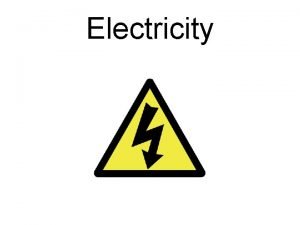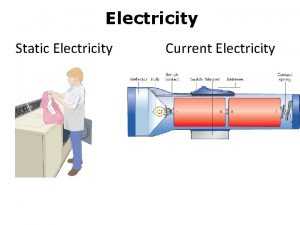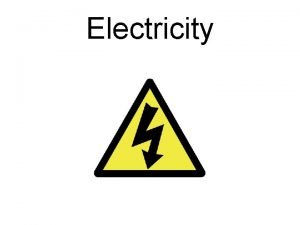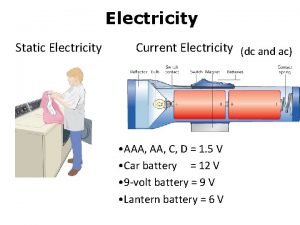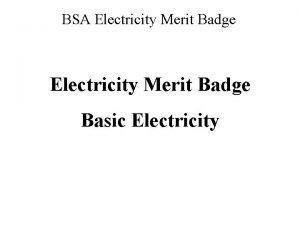Safe procedures when working with electricity Safe procedures


























- Slides: 26

Safe procedures when working with electricity

Safe procedures when working with electricity: • General electrical safety • Safe isolation • Voltage reduction to improve safety • Portable electrical equipment • Earthing • Levels of electric shock • Working in damp atmospheres • Working in confined spaces • Checking plugs and cables • Procedures to be followed in the event of electric shock • PPE specifically for electrical work

• General electrical safety – Electricity can kill. Each year about 1000 accidents at work involving electric shock or burns are reported to the Health and Safety Executive (HSE). Around 30 of these are fatal. Most of these fatalities arise from contact with overhead or underground power cables. Even non-fatal shocks can cause severe and permanent injury. Shocks from faulty equipment may lead to falls from ladders, scaffolds or other work platforms. Those using electricity may not be the only ones at risk, as poor electrical installations and faulty electrical appliances can lead to fires which may also cause death or injury to others. Yet most of these accidents can be avoided by careful planning and taking straightforward precautions. *WARNING – THE NEXT SLIDE CONTAINS EXPLICIT IMAGES OF ELECTRIC SHOCK VICTIMS!

• General electrical safety – Entrance Wound: High resistance of skin transforms electrical energy into heat, which produces burns around the entrance point (dark spot in center of wound). This man was lucky, the current narrowly missed his spinal cord. Exit Wound: Current flows through the body from the entrance point, until finally exiting where the body is closest to the ground. This foot suffered massive internal injuries, which weren't readily visible, and had to be amputated a few days later.

• General electrical safety – The main hazards are: • Contact with live parts causing shock and burns (mains voltage at 230 volts AC can kill). • Faults which could cause fires. • Fire or explosion where electricity could be the source of ignition in a potentially flammable or explosive atmosphere, eg in a spray paint booth.

• General electrical safety – The risk of injury from electricity is also strongly linked to where and how it is used. The risks are greatest in harsh conditions. Any ideas? In wet surroundings - unsuitable equipment can easily become live and can make its surroundings live Out of doors - equipment may not only become wet but may be at greater risk of damage In cramped spaces with a lot of earthed metalwork, such as inside a tank. If an electrical fault developed here it could be very difficult to avoid a shock Some items of equipment can also involve greater risk than others. Extension leads are particularly liable to damage - to their plugs and sockets, to their electrical connections, and to the cable itself. Other flexible leads, particularly those connected to equipment which is moved a great deal, can suffer from similar problems.

• Safe isolation – Note that electrical testing must only be carried out by a competent person, or be closely supervised by a competent person! Many fatal electrical accidents occur during the proving of isolation. Electricians must be on guard, as they may not know the type of supply they are dealing with. Before beginning work on any electrical circuit care should be taken to ensure that it is completely isolated from the supply by following recognised procedures: What do you think they should be? • Identify sources of supply • Isolate • Secure the isolation with a padlock and display notices • Test the equipment/system is dead • Confirm test equipment is ok on proving unit • Re-test the equipment/system is dead • Begin work - with care

• Voltage reduction to improve safety – Soldering stations Soldering irons are used to make connections between electronic components and circuit boards. They are usually supplied with a soldering station, which has a transformer built in to reduce the voltage to a safe level. The soldering iron can reach 300 degrees Celsius, so care must be taken not to touch the bit or to burn through cables. It should be kept in the stand when not in use. Solder is supplied on a reel, and must not be flicked off the iron under any circumstances, as this can cause blindness, or skin burns.

• Voltage reduction to improve safety – Control circuits often employ a lower voltage supply such as 24 volts d. c. This level of supply is often used for control circuits, supplying start and stop push buttons for machines. 400 volt motors can still be controlled at 24 volts d. c. by using contactors and relays. If control panels are damaged, exposing wiring, then it is not as dangerous at this voltage level. Safety and power tools Battery – powered hand tools Battery operated power tools are the tool of choice when working on site, they avoid the use of trailing power leads and other dangers associated with power leads. Pneumatically operated tools are another option.

Voltage reduction to improve safety – Use a transformer supplying 110 volts a. c. This type of transformer reduces the output voltage, which gives an obvious benefit with regards to safety when using power tools and portable equipment. • 110 Volt Power Tool Transformers convert mains 240 v to 110 v for construction site use.

• Portable equipment general care – • Ensure that equipment and extension leads are safe when supplied and then maintained in a safe condition. • Regularly arrange to carry out Portable Appliance Testing (P. A. T. ) • For portable equipment, use socket-outlets which are close by so that equipment can be easily disconnected in an emergency. • The ends of flexible cables should always have the outer sheath of the cable firmly clamped to stop the wires (particularly the earth) pulling out of the terminals

• Portable equipment general care – • Replace damaged sections of cable completely. • Use proper connectors or cable couplers to join lengths of cable. • Do not use strip connector blocks covered in insulating tape. • Check electrical equipment used in flammable/explosive atmospheres. It should be designed to stop it from causing ignition. You may need specialist advice. • Some types of equipment are double insulated. These are often marked with a ‘double-square’ symbol. The supply leads have only two wires. Make sure they are properly connected if the plug is not a moulded-on type, especially with the new change in cable colours. This is the symbol for ‘double insulation’

• Earthing – We can express the reason why electrical appliances are earthed with one word ‘Safety’. If we did not earth, the possibility would exist for the metalwork of an appliance or an installation, (e. g. metal drill casing, metal switch cover, etc. ), becoming live, with any contact with this casing resulting in a fatal accident. The diagram below shows a person in contact with a correctly earthed system as an earth fault occurs. A person touching metalwork which had become live, should if the system is soundly earthed, receive no electric shock, as the resistance of the human body would be considerably greater than the resistance of the earth path. This would result in the fault current flowing through the earthing system & not the person, (i. e. current takes the path of least resistance). Note: 80 k = 80, 000

Electric Shock Electric shock is the passage of current through the body of such magnitude as to have significant harmful effects. 50 m. A & above is enough to kill you A kettle draws 6 A, 120 times more than this!!

• Working in damp atmospheres – Residual Current device (RCD) This is essential when using equipment in damp conditions such as outdoors. If equipment operating at 230 volts or higher is used, an RCD (residual current device) can provide additional safety. The best place for an RCD is built into the main switchboard or the socket-outlet, as this means that the supply cables are permanently protected. If this is not possible a plug incorporating an RCD, or a plug-in RCD adaptor, can also provide additional safety.

Residual Current device (RCD) • An RCD is a valuable safety device, never bypass it. • If an RCD trips, it is a sign there is a fault. • Check the system before using it again. • If the RCD trips frequently and no fault can be found in the system, consult the manufacturer of the RCD. • The RCD has a test button to check that its mechanism is free and functioning. Use this regularly. .

• Checking plugs and cables for condition – It’s a good idea to check these regularly. Plugs and their cables can be damaged with use. Here’s how to check the common, square-pin 13 -amp plug used in all modern appliances. DO NOT USE ANY FAULTY EQUIPMENT – REPORT IT STRAIGHT AWAY! Check the cable: Is the cable securely attached to the appliance and the plug? Is the cable cut, nicked or damaged in any way? There should be no joints and no repairs with insulating tape. Check the plug: Look for cracks or damage on the casing. Look for signs of overheating, such as discoloured casing or cable. Check the plug meets British Standards – it will be marked on the back. Check that the cable is firmly clamped into the plug and no coloured wires are showing.

• Procedures to be followed in the event of electric shock Do not panic! It may be tempting to, but try to control your nerves until after the event. Make sure the area is safe for you to enter – with regards to live cables, chemicals, unsafe buildings etc. If a person is receiving an electric shock, it is necessary to either disconnect the supply, or remove the person from the live equipment (whichever is quickest). Do not to touch the person whilst they are receiving the shock or else you will get the shock too! If removal is quickest, it is important to use something made of an insulator such as dry wood, like a broom handle, to stop the person receiving the shock. Do not forget to call 999 or ask someone else to do it.

• Procedures to be followed in the event of electric shoc START: NEXT:

• Personal Protective Equipment used when working with electricity – Note: It is assumed that general engineering PPE will be covered in other sessions Dielectric (insulated) boots Suitable for Electrical Contractors, Utility Workers, Electric Welders, Telecom Workers, Slaughterhouse Workers, etc Resists 20 000 volts on the complete boot – resists 35 000 volts on the sole Dielectric with Steel Toe cap and Rubber Sole Fuel & Oil resistant vulcanised rubber sole High visibility yellow compound See: www. boddingtons-electrical. com

• Personal Protective Equipment used when working with electricity – Note: It is assumed that general engineering PPE will be covered in other sessions Rubber High Voltage gloves Insulating electrical rubber gloves Test stamped for working voltages ranging from 500 V up to 36, 000 V Leather overglove worn over the insulating rubber gloves to protect against mechanical hazards and electrical arcing Cotton undergloves give added comfort in warm and humid conditions - worn as a liner to the electrical rubber gloves Visual inspection by inflation of the electrical rubber glove in order to detect air leaks, this can be carried out by the Pneumatic Rubber Glove Tester See: www. boddingtons-electrical. com

• Working in confined spaces – Confined space means a space that has any of the following characteristics: • limited openings for entry and exit; • unfavourable natural ventilation; • not designed for continuous worker occupancy. It includes, but is not limited to: furnaces, boilers, pressure vessels, ship cargo holds, ballast tanks, fuel oil tanks, sewage-tanks, pump-rooms, compressor rooms, void spaces. Metal tanks and enclosures must be earthed properly. Ideally power tools should be battery or pneumatic powered. Otherwise, RCD devices must be used in addition to reduced voltage power supplies. A ‘Permit to Enter’ must be issued, and proper procedures followed in this potentially dangerous activity.

• Working in confined spaces – Work in confined and enclosed space has a greater likelihood of causing fatalities, severe injuries and illness than many other types of work. The key hazards associated with confined spaces are: • serious risk of fire or explosion; • loss of consciousness from asphyxiation arising from gas, fumes, vapour or lack of oxygen; • drowning arising from increased water/liquid level; • loss of consciousness arising from an increase in body temperature; • asphyxiation/suffocation arising from free flowing solid (engulfment) or the inability to reach a breathable atmosphere due to entrapment. • Increased risk of electrocution due to metal tanks, and risk of power to heating elements being accidentally switched on.

• Working in confined spaces – Surveyors will routinely enter confined spaces that are difficult to access due to small and/or narrow openings. There may be physical constraints within the space which need to be considered, and the space itself may be cramped permitting only restricted mobility. Given the usual enclosed and darkened nature of a confined space this activity ideally should not be carried out by persons suffering from phobias (e. g. claustrophobia) or who are susceptible to panic or anxiety attacks.

• Case study – March 2003 • Two engineers died while working on a disused marine fuel tank on a Suffolk waterway. • The bodies of the two men, both believed to have been married with children, were recovered after a seven-hour operation involving firefighters, paramedics, police, coastguard and harbour workers. • They had been working in the five-metre diameter, 15 -metre long tank at the shore of Lake Lothing, Lowestoft, when they became trapped. • After a dramatic seven-hour operation involving more than 30 firefighters from across Suffolk, it was revealed that the two men had died. • It is believed they were overcome by fumes. • The men, who were welders for a Lowestoft-based marine engineering company had been working inside one of four partly submerged tanks moored together off land owned by Associated British Ports (ABP) and across the water from dry docks belonging to their employer.

• Working in confined spaces – Case study – July 2001. Two men were killed in an industrial bread oven. The men were carrying out maintenance work when they became trapped and were carried through the 75 foot oven on a conveyer belt. Unable to escape, they died from burns and heat exposure. One of the men suffered 80% burns. The men, who were trying to retrieve a broken part, became trapped as temperatures inside the bread oven rose to 100 C. Three company directors pleaded guilty to charges under the Health and Safety at Work Act 1974.
 Static electricity and current electricity
Static electricity and current electricity Current electricity
Current electricity How are static electricity and current electricity alike
How are static electricity and current electricity alike Advantages of hot working over cold working
Advantages of hot working over cold working Hot working and cold working difference
Hot working and cold working difference Machining operations
Machining operations Hard work or smart work
Hard work or smart work Proses pengerjaan panas
Proses pengerjaan panas Safe lab procedures
Safe lab procedures Safe lab procedures
Safe lab procedures Softeners for rigging
Softeners for rigging Safe lab procedures and tool use
Safe lab procedures and tool use No part of an oxygen cylinder wall is thinner than ____.
No part of an oxygen cylinder wall is thinner than ____. Safe working practices on board ships
Safe working practices on board ships Safe people safe places
Safe people safe places Safe feed safe food
Safe feed safe food Why we need electricity
Why we need electricity Anaphoresis and cataphoresis
Anaphoresis and cataphoresis Electricity merit badge powerpoint
Electricity merit badge powerpoint Unit 10 electricity
Unit 10 electricity Ib physics electricity and magnetism
Ib physics electricity and magnetism Cim compliance
Cim compliance Electric fence experiment
Electric fence experiment Chapter 32 electrostatics
Chapter 32 electrostatics Tricity electricity
Tricity electricity Electricity section 1 electric charge
Electricity section 1 electric charge Static electricity tape lab
Static electricity tape lab




























